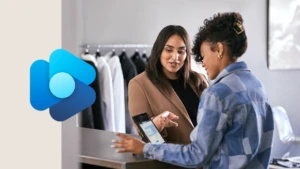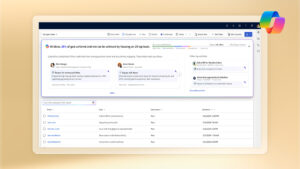
Microsoft at NRF: the changing landscape of retail
With NRF Chapter 1 starting this week, many retailers are looking to 2021 with one prominent thought: what’s next? Microsoft Dynamics 365 will again play a prominent role in Retail’s Big Show with new announcements and showcasing customer agility and innovation amidst a very disrupted market.
It’s clear that 2020 was a year where the retail industry went through rapid transformation; it’s less clear which of these changes are permanent and how retailers should prepare for 2021 and beyond. In a recent study by Forrester, commissioned by Microsoft, over 83 percent of executives agreed that connected and unified experiences were key to business success and digital commerce was a core ingredient. Of the 600 consumer-facing businesses surveyed, over 75 percent of companies said that improving digital commerce capabilities is their most urgent business priority.
Digital commerce is now the face of retail
The global pandemic has shifted how we buy, pushing more people to shop online than ever before. Fifty-nine percent of American consumers reported shopping online more often since the pandemic, according to CouponFollow, and data from the U.S. Department of Commerce shows that e-commerce sales grew as much from mid-June to mid-August as they did over the previous ten years—a staggering increase. And in 2020, 71 percent of holiday shoppers planned to do most of their shopping online, up from 51 percent in 2019, according to CreditCards.com.
While we anticipate in-store sales will rebound as the pandemic subsides—we’ve already seen comfort with in-store shopping increase 65 percent since April, from 34 percent to 56 percent, according to Deloitte—it’s also clear that digital commerce has seen tremendous growth during the pandemic, and this trend is expected to continue. Sixty-six percent of consumers stated they’d likely continue to purchase items online that they’d previously bought in-store prior to the pandemic, according to CouponFollow. And according to a recent report by Ipsos by 2023, e-commerce will represent 22 percent of global retail sales, amounting to $6.5 trillion USD. By 2021, it projects that 2.14 billion people worldwide will be buying goods and services online.
No matter the size of your business, digital commerce can no longer be an afterthought. Where brick-and-mortar locations were once the face of many companies, digital storefronts and online experiences now define many retail brands and will be key to unlocking growth and new opportunities.
Online shopper demographics have shifted
Younger shoppers—Millennials and Gen-Z—have long been the primary users of online shopping, but the pandemic has caused major changes to who is shopping online. While Millennials and Gen-Z continue to shop online at high rates, we’ve seen 60 percent of Gen Xers and 47 percent of Boomers report increasing their online shopping from before the pandemic, according to CouponFollow. Also, according to eMarketer more than 30 percent of Boomers tried or were considering online grocery shopping, with some planning to continue doing so long-term, while 70 percent of both Gen Xers and Boomers plan on doing most of their holiday shopping online this year.
While shutdowns and safety concerns were the likely drivers of this adoption, they may not be the reason these groups are continuing to shop online. In a September poll by CreditCards.com, convenience was the top-cited reason older shoppers purchased online, with 76 percent of Boomers and 83 percent of Silent Generation shoppers agreeing. Other top-cited reasons include finding better deals (46 percent) and a bigger selection (44 percent). Interestingly, “avoiding human contact” was conversely correlated to age, with the youngest shoppers demonstrating the highest degree of caution, 59 percent of Gen-Zers, and only 48 percent and 47 percent of Boomers and Silent Generation shoppers, respectively.
The increase in online shopping among older users, in conjunction with their motivations for doing so, suggests that these changes may have been caused by the pandemic, but they are not being upheld by the pandemic. And therefore, we anticipate this shift will continue after the pandemic. Businesses need to consider these new users when developing digital retail strategies, including user experiences for customers who may be less tech-savvy than many younger users.
Customer experience means maximum flexibility
As we’ve discussed, the pandemic has driven more shoppers online. But it has done more than that; it has pushed retailers to offer maximum flexibility for their customers, both online, offline, and in bridging the gap between the two.
This started with changes to return policies, which became an important tool for retailers to help customers feel comfortable making the types of purchases that they were accustomed to making in-person, such as apparel, where fit is essential. In an April survey published by eMarketer, 40 percent of U.S. retailers had adjusted their return policies due to the coronavirus pandemic, while 27 percent were considering doing so.
To help ensure the safety of their employees and patrons, many brick-and-mortar stores made changes to their in-store environments. For many, plexiglass dividers have become commonplace at checkout. Contactless payments and mobile point of sale have also seen a surge of adoption during the pandemic. According to the State of Retail Payments study conducted by NRF and Forrester, 67 percent of retailers surveyed now accept some form of no-touch payment, with 56 percent accepting digital wallet payments on mobile phones, up from 44 percent from last year. No-touch payments have increased 69 percent since January 2020, according to retailers surveyed.
Another significant change has been the adoption of buy online, pick up in-store (BOPIS), both by retailers and consumers, especially older shoppers. Over 60 percent of Boomers are aware of BOPIS—more than any of their younger counterparts, and two-thirds have tried BOPIS, with 63 percent saying it has improved their shopping experience, according to the National Retail Federation.
Flexibility has been a growing trend in retail and fulfillment, but many of the things that were once requests are now requirements. And post-pandemic, these requirements will become the expectation. Customers want and need maximum flexibility with how they engage with customers—whether through personalization, social media engagement, or omnichannel purchasing—and the retailers who continue to thrive will be those that let shoppers engage on their terms.
The future of retail engagement
As we look forward to 2021, digital engagement will continue to unlock new opportunities for those retailers who choose to embrace it. For many, online has become their new norm. Others have bridged the gap between online and in-store experiences, like with BOPIS or curbside collection. And when more physical retail environments open, retailers will have to contend with the new reality that in-store shopping is less about purchasing and more about delivering a richer shopping experience.
This week at NRF 2021, the Microsoft Business Applications team will demonstrate how Dynamics 365 makes it possible for retail businesses to quickly launch and enhance their digital commerce platform, deliver secure and personalized service, and modernize their in-store experiences.
If you are registered for NRF 2021, we invite you to join Shelley Bransten, Microsoft’s Corporate Vice President, Consumer Goods and Retail Industries, to learn how Microsoft is empowering retailers from across the globe to build more intelligent, resilient, and sustainable retail operations. Tune in on Wednesday, January 13, 2021 at 1:00 PM Eastern Time.
Also, continue to visit the Dynamics 365 blog this week to learn more about how Microsoft Dynamics 365 and Microsoft Power Platform are helping retailers reimagine the road ahead with truly engaged, always connected solutions.




